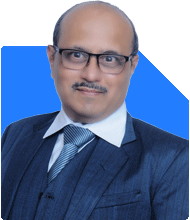Should I Invest in a House or Mutual Funds with ?7 Lacs?
Ramalingam Kalirajan |10906 Answers |Ask -Follow
Mutual Funds, Financial Planning Expert - Answered on Sep 11, 2024
He has an MBA in finance from the University of Madras and is a certified financial planner.
He is the director and chief financial planner at Holistic Investment, a Chennai-based firm that offers financial planning and wealth management advice.... more

Hello Sir, I currently have ?7 lacs idle in my savings account and I'm exploring the best way to manage this, considering my financial situation and future needs. My financial overview includes: monthly investments in equity mutual funds with a long-term perspective, comprehensive health and term insurance, an emergency fund covering 6 months expenses, and an additional ?50k saved each month after all expenditures and SIP contributions. Additionally, I hold ?4.75 lacs in another account for immediate needs. I aim to categorize my investments into non-withdrawal mutual funds for long-term compounding benefits and withdraw-able mutual funds for safer, more liquid options that beat inflation. I seek advice on managing these funds and specific mutual fund recommendations, as I might need access to this money (or not need) within 2-5 years. Any guidance would be greatly appreciated!
In addition to your Rs. 7 lakhs of idle savings and Rs. 4.75 lakhs set aside for immediate needs, you also have an impressive Rs. 50,000 in monthly savings after all expenses and investments. This presents a strong base for further wealth creation, and managing these funds effectively will help you meet your short-term and long-term goals. Let’s explore how you can maximize the potential of your idle funds, taking into account both liquidity needs and long-term compounding.
Categorizing Funds: Long-Term and Short-Term Investments
Your decision to divide your investments into two categories—non-withdrawable mutual funds for long-term growth and withdrawable mutual funds for short-term liquidity—is a sound approach. This division allows you to meet both your immediate financial needs while simultaneously growing your wealth over the long term.
Long-Term Investment: Non-Withdrawal Funds (2-5 Years and Beyond)
For long-term compounding, equity mutual funds are an ideal vehicle. You’re already investing in these funds with a long-term perspective, which is excellent, as equity tends to outperform other asset classes like debt or fixed deposits over time.
Here’s how you can further optimize your long-term investment strategy:
Continue SIPs in Equity Mutual Funds: Regular investments through Systematic Investment Plans (SIPs) allow you to benefit from rupee cost averaging. This means you buy more units when markets are down and fewer units when markets are up, thus averaging your cost over time. Given that you already have SIPs in place, it’s advisable to continue with these contributions. Over the long term, equity markets tend to grow despite short-term volatility, and consistent investments will help you capitalize on this growth.
Lump Sum Allocation from Idle Funds: Since you have Rs. 7 lakhs sitting idle in your savings account, which is currently not earning much interest, it’s prudent to put a portion of this amount into equity mutual funds. You could allocate Rs. 4-5 lakhs of this sum towards equity mutual funds to boost your long-term growth. This will allow the funds to compound over time, helping you accumulate wealth more effectively.
Benefits of Actively Managed Funds Over Index Funds: While index funds track a specific index like the Nifty 50, they are often less flexible and cannot adjust to changing market conditions. On the other hand, actively managed funds, overseen by professional fund managers, have the ability to change their asset allocation based on market trends, thus potentially offering higher returns. Although index funds may have lower fees, they may not always outperform actively managed funds, especially in a volatile or uneven market.
Avoid Direct Funds for Better Portfolio Management: Direct mutual funds, although they come with a lower expense ratio, require constant tracking and decision-making. This can be cumbersome for someone who may not have the time or expertise to monitor the markets closely. Investing through a Mutual Fund Distributor (MFD) who has a Certified Financial Planner (CFP) credential will allow you to benefit from expert advice and portfolio management. A CFP can help optimize your portfolio by selecting the right mix of funds based on your risk tolerance, financial goals, and market conditions. Additionally, the long-term relationship with an MFD/CFP can ensure timely adjustments to your portfolio.
Short-Term Investment: Withdrawable Funds (2-5 Years)
For the portion of your savings that you may need within the next 2-5 years, you need safer and more liquid investment options. While equity mutual funds are great for long-term growth, they can be volatile in the short term, which makes them less suitable for funds you might need soon. Here’s how you can structure your short-term investments:
Hybrid Funds: These funds offer a balanced approach by investing in both equities and debt instruments. The equity portion provides the opportunity for growth, while the debt portion offers stability and reduces volatility. Hybrid funds are less risky than pure equity funds and provide a good option for investors looking to beat inflation while keeping the investment relatively safe.
Short-Term Debt Funds: Debt mutual funds invest in government securities, corporate bonds, and other fixed-income instruments. These funds are less volatile than equity mutual funds, making them ideal for short-term investments. By investing in debt funds with shorter maturity periods, you can achieve relatively higher returns than a savings account while ensuring that the risk is low. Debt funds can also provide liquidity, allowing you to withdraw your money when needed.
Liquid Funds: For funds that you need to access quickly, liquid mutual funds are a good option. These funds invest in short-term, low-risk instruments and offer better returns than a regular savings account. Importantly, liquid funds allow you to withdraw money with minimal hassle, often within 24 hours. Since you might need access to your savings for immediate or unexpected expenses, liquid funds are an ideal choice to park part of your Rs. 7 lakhs.
Avoid Index Funds for Short-Term Goals: Index funds, though popular for their simplicity and low costs, may not be suitable for short-term investments. They follow the market and cannot adapt quickly to changing economic conditions. If the market experiences a downturn during the period when you need your funds, you might be forced to withdraw at a loss. Therefore, for short-term investments, it’s better to focus on debt or hybrid funds that offer stability.
Strategic Allocation of Rs. 7 Lakhs
Given your financial goals and the possibility that you may need access to some of your savings within the next 2-5 years, here’s how you can strategically allocate your Rs. 7 lakhs:
Rs. 4-5 Lakhs for Long-Term Growth: Allocate a significant portion of your idle Rs. 7 lakhs into long-term equity mutual funds. This will allow you to take advantage of market compounding and generate wealth over time. Equity funds, despite short-term volatility, tend to offer the highest returns over periods of 5 years or more.
Rs. 2-3 Lakhs for Short-Term Flexibility: Park the remainder of your Rs. 7 lakhs into safer, more liquid investments such as hybrid or debt funds. These funds provide a good balance between safety and returns, allowing your money to grow while being accessible when needed. If you find that you don’t need these funds in 2-3 years, you can always move them into more aggressive investments later.
Managing the Rs. 4.75 Lakhs for Immediate Needs
You’ve wisely set aside Rs. 4.75 lakhs in another account for immediate needs. Since this money may be required at any time, it’s essential to keep it in a highly liquid and low-risk option.
Liquid Mutual Funds: As mentioned earlier, liquid funds are an excellent choice for immediate needs. They offer liquidity similar to a savings account but with the potential to earn higher returns. Liquid funds invest in short-term instruments and typically allow you to access your money within a day, making them ideal for emergency funds or immediate expenses.
High-Interest Savings Account: Alternatively, you can keep this money in a high-interest savings account. This option provides both safety and liquidity, though the returns may not beat inflation over the long term. However, since the primary goal for this Rs. 4.75 lakhs is to maintain accessibility, a high-interest savings account could be a good secondary option.
Utilizing Rs. 50,000 in Monthly Savings
Your ability to save Rs. 50,000 per month after all expenses and investments is a strong indicator of financial discipline. This surplus can be put to excellent use for both short-term flexibility and long-term wealth creation.
Increase Equity SIP Contributions: You could allocate a portion of your Rs. 50,000 monthly savings to increase your SIP contributions in equity mutual funds. This will allow you to compound your wealth even faster. Since equity markets can experience ups and downs, adding more to your SIPs during market downturns will help you purchase more units at a lower cost, thus improving long-term returns.
Allocate to Short-Term SIPs: You can also consider starting or increasing your SIPs in short-term hybrid or debt mutual funds. These funds provide stability and liquidity while offering better returns than traditional savings instruments. By allocating part of your monthly savings to these funds, you create a pool of investments that can be tapped into for medium-term goals or unexpected needs.
Final Insights
In conclusion, you are on the right track with your investments and financial planning. To enhance your financial portfolio and ensure both long-term growth and short-term liquidity, consider the following strategies:
Allocate Rs. 4-5 Lakhs from your idle Rs. 7 lakhs into long-term equity mutual funds for compounding benefits over the next 5 years and beyond. Equity mutual funds are ideal for wealth creation and will help you meet your future financial goals.
Invest Rs. 2-3 Lakhs in short-term debt or hybrid mutual funds. These funds offer a balance between safety and returns, ensuring your funds are accessible when needed while also beating inflation.
Keep the Rs. 4.75 lakhs set aside for immediate needs in liquid mutual funds. Liquid funds will give you quick access to your money, while also providing higher returns than a savings account.
Use your Rs. 50,000 in monthly savings to increase your SIP contributions. By boosting your long-term equity investments and adding to short-term hybrid or debt funds, you can ensure that your financial plan remains flexible while growing your wealth steadily.
By following these recommendations, you will not only optimize your current investments but also lay a strong foundation for future financial security. The balance between long-term growth and short-term flexibility is key to meeting your financial goals, and with consistent efforts, you will continue to strengthen your financial portfolio.
Best Regards,
K. Ramalingam, MBA, CFP,
Chief Financial Planner,
www.holisticinvestment.in
You may like to see similar questions and answers below
Omkeshwar Singh | Answer |Ask -Follow
Head, Rank MF - Answered on Jul 07, 2022
Ramalingam Kalirajan |10906 Answers |Ask -Follow
Mutual Funds, Financial Planning Expert - Answered on Jun 04, 2024
Milind Vadjikar | Answer |Ask -Follow
Insurance, Stocks, MF, PF Expert - Answered on Sep 11, 2024
Ramalingam Kalirajan |10906 Answers |Ask -Follow
Mutual Funds, Financial Planning Expert - Answered on Sep 03, 2025
Nitin Narkhede |113 Answers |Ask -Follow
MF, PF Expert - Answered on Sep 03, 2025
Naveenn Kummar |237 Answers |Ask -Follow
Financial Planner, MF, Insurance Expert - Answered on Dec 20, 2025
Ramalingam Kalirajan |10906 Answers |Ask -Follow
Mutual Funds, Financial Planning Expert - Answered on Dec 19, 2025
Nayagam P P |10859 Answers |Ask -Follow
Career Counsellor - Answered on Dec 19, 2025
Ramalingam Kalirajan |10906 Answers |Ask -Follow
Mutual Funds, Financial Planning Expert - Answered on Dec 19, 2025
Ramalingam Kalirajan |10906 Answers |Ask -Follow
Mutual Funds, Financial Planning Expert - Answered on Dec 19, 2025
Ramalingam Kalirajan |10906 Answers |Ask -Follow
Mutual Funds, Financial Planning Expert - Answered on Dec 19, 2025
Radheshyam Zanwar |6751 Answers |Ask -Follow
MHT-CET, IIT-JEE, NEET-UG Expert - Answered on Dec 19, 2025
Radheshyam Zanwar |6751 Answers |Ask -Follow
MHT-CET, IIT-JEE, NEET-UG Expert - Answered on Dec 19, 2025
Samraat Jadhav |2514 Answers |Ask -Follow
Stock Market Expert - Answered on Dec 18, 2025
Reetika Sharma |432 Answers |Ask -Follow
Financial Planner, MF and Insurance Expert - Answered on Dec 18, 2025











.jpg)
















